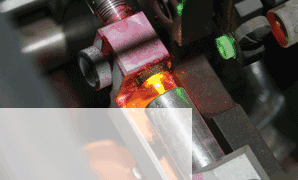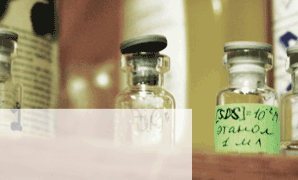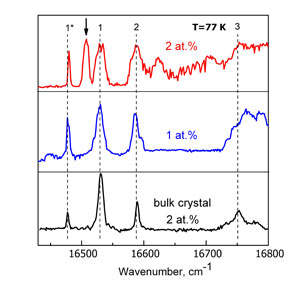 |
Home  Team Team  Contact us Contact us |
| About us | Our activity | Highlights | Publications | Gallery | New events |
| RE-doped nanocrystals | J-aggregates | Cell marking | Inorganic synthesis | Organic synthesis |
 |
 |
 |
Strong doped ions segregation in strain gradient of Y2SiO5:Pr3+ and YVO4:Er3+,Yb3+ nanocrystals
The development of nanophosphors as promising materials for various modern light applications requires precise and controlled fabrication of nanostructures in a volume and on a surface. The optical and luminescence properties of nanophosphors as well as bulk phosphors are known to determine by the small portion of doped rare-earth (RE) or transition metal ions. The surface produced strain gradient penetrating of most part of nanocrystal could stimulate a total uphill diffusion of doped ions which are surrounded by own stress field.
So, the sufficient fraction of doped ions could be expected to segregate and elastically stretched region (nearby surface) of nanocrystal will be enriched with ions having radius greater in comparison with regular one and vice versa.
Our results:
We have observed abnormal low 1D2-3H4 luminescence concentration quenching threshold for Y2SiO5:Pr3+ nanocrystals. The analysis of luminescence excitation spectra of Y2SiO5:Pr3+ nanocrystals with different Pr3+ concentrations have revealed the formation of Pr3+ pairs at low Pr concentration (fig.1). These effects have been explained by the effect of doped ion segregation within nanocrystal surface determined by size difference for impurity and regular ion.
fig.1. 3H4-1D2 excitation spectra of Y2SiO5:Pr3+ nanocrystals at different Pr concentrations and 3H4-1D2 absorption spectrum of Y2SiO5:Pr3+ bulk crystal with Pr concentration of 2 at.%. T = 77 K. The line assigned to the pair state is marked with the arrow.
To show generality and importance of the surface segregation phenomena in doped nanocrystals, well-known YVO4:Er3+,Yb3+ crystal, which demonstrates an efficient up-conversion has been selected. Temperature treatment of YVO4:Er3+,Yb3+ nanocrystals at 650 C leads to the significant increase of the red-to-green ratio, as if we deal with Er3+ concentration increasing (fig.2).

fig. 2. Up-conversion luminescence spectra of YVO4:Er3+ (0.5 at.%), Yb3+ (10 at.%)
nanocrystals before and after annealing
Main publications:
A.A.Masalov, O.G. Vyagin, I.I. Ganina, Yu.V. Malyukin. Strong quenching of praseodymium f f luminescence induced by a surface of Y2SiO5:Pr3+ nanocrystal// Journal of Luminescence 2009. v.129., Ή 12. P.1695-1697. abstract
Yu.V. Malyukin, P.N. Zhmurin, N.V. Zhnamenski, T.G. Yurkina, Strong quenching of Y2SiO5:Pr3+ nanocrystal luminescence by praseodymium nonuniform distribution // Phys. Stat. Sol.(b) 2007. v.244., Ή 9. P.3325-3332. abstract
to the top

